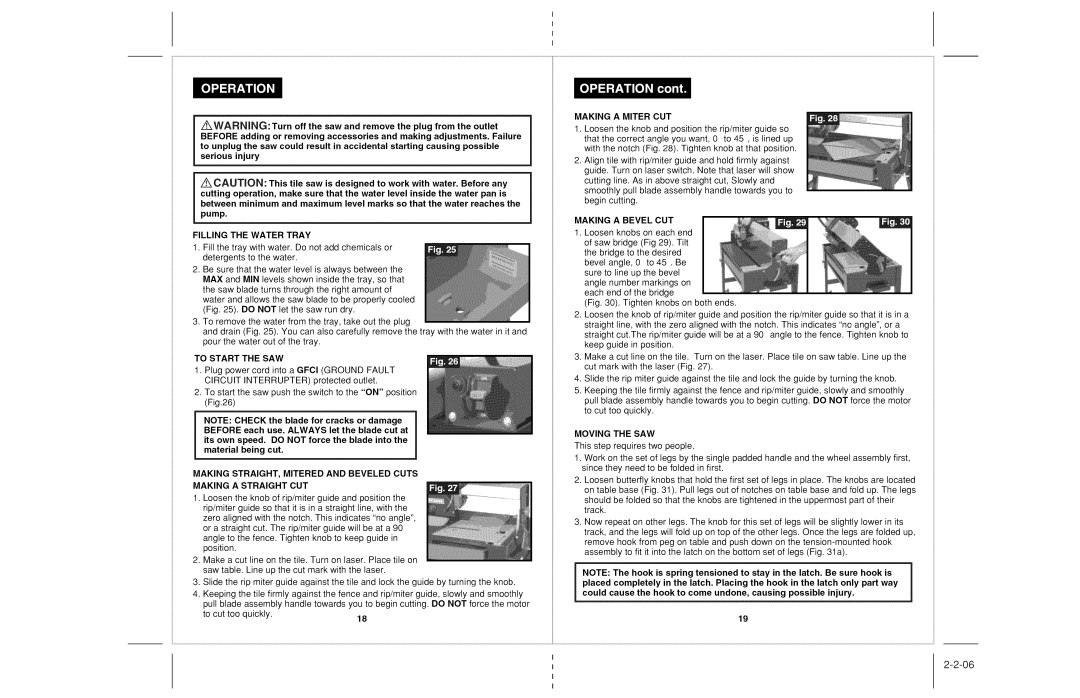
I I I I
z_WARNiNG:Turn off the saw and remove the plug from the outlet
BEFORE adding or removing accessories and making adjustments. Failure to unplug the saw could result in accidental starting causing possible serious injury
ACAUTION: This tile saw is designed to work with water. Before any cutting operation, make sure that the water level inside the water pan is between minimum and maximum level marks so that the water reaches the pump.
FILLING THE WATER TRAY
1.Fill the tray with water. Do not add chemicals or detergents to the water.
2.Be sure that the water level is always between the MAX and MIN levels shown inside the tray, so that the saw blade turns through the right amount of water and allows the saw blade to be properly cooled (Fig. 25). DO NOT let the saw run dry.
3.To remove the water from the tray, take out the plug
and drain (Fig. 25). You can also carefully remove the tray with the water in it and pour the water out of the tray.
TO START THE SAW
1.Plug power cord into a GFCl (GROUND FAULT CIRCUIT INTERRUPTER) protected outlet.
2.To start the saw push the switch to the "ON" position (Fig.26)
NOTE: CHECK the blade for cracks or damage
BEFORE each use. ALWAYS let the blade cut at its own speed. DO NOT force the blade into the material being cut.
MAKING STRAIGHT, MITERED AND BEVELED CUTS
MAKING A STRAIGHT CUT
1.Loosen the knob of rip/miter guide and position the rip/miter guide so that it is in a straight line, with the zero aligned with the notch. This indicates "no angle", or a straight cut. The rip/miter guide will be at a 90 angle to the fence. Tighten knob to keep guide in position.
2.Make a cut line on the tile. Turn on laser. Place tile on saw table. Line up the cut mark with the laser.
3.Slide the rip miter guide against the tile and lock the guide by turning the knob.
4.Keeping the tile firmly against the fence and rip/miter guide, slowly and smoothly pull blade assembly handle towards you to begin cutting. DO NOT force the motor
to cut too quickly. | 18 |
MAKING A MITER CUT
1.Loosen the knob and position the rip/miter guide so that the correct angle you want, 0 to 45 , is lined up with the notch (Fig. 28). Tighten knob at that position.
2.Align tile with rip!miter guide and hold firmly against guide. Turn on laser switch. Note that laser will show cutting line. As in above straight cut, Slowly and smoothly pull blade assembly handle towards you to begin cutting.
MAKING A BEVEL CUT
1.Loosen knobs on each end of saw bridge (Fig 29). Tilt the bridge to the desired bevel angle, 0 to 45 . Be sure to line up the bevel angle number markings on each end of the bridge
(Fig. 30). Tighten knobs on both ends.
2.Loosen the knob of rip/miter guide and position the rip/miter guide so that it is in a straight line, with the zero aligned with the notch. This indicates "no angle", or a straight cut.The rip/miter guide will be at a 90 angle to the fence. Tighten knob to keep guide in position.
3.Make a cut line on the tile. Turn on the laser. Place tile on saw table. Line up the cut mark with the laser (Fig. 27).
4.Slide the rip miter guide against the tile and lock the guide by turning the knob.
5.Keeping the tile firmly against the fence and rip/miter guide, slowly and smoothly pull blade assembly handle towards you to begin cutting. DO NOT force the motor to cut too quickly.
MOVING THE SAW
This step requires two people.
1.Work on the set of legs by the single padded handle and the wheel assembly first, since they need to be folded in first.
2.Loosen butterfly knobs that hold the first set of legs in place. The knobs are located on table base (Fig. 31). Pull legs out of notches on table base and fold up. The legs
should be folded so that the knobs are tightened in the uppermost part of their track.
3.Now repeat on other legs. The knob for this set of legs will be slightly lower in its track, and the legs will fold up on top of the other legs. Once the legs are folded up, remove hook from peg on table and push down on the
NOTE: The hook is spring tensioned to stay in the latch. Be sure hook is placed completely in the latch. Placing the hook in the latch only part way could cause the hook to come undone, causing possible injury.
19
I
I2-2-06
I
I
